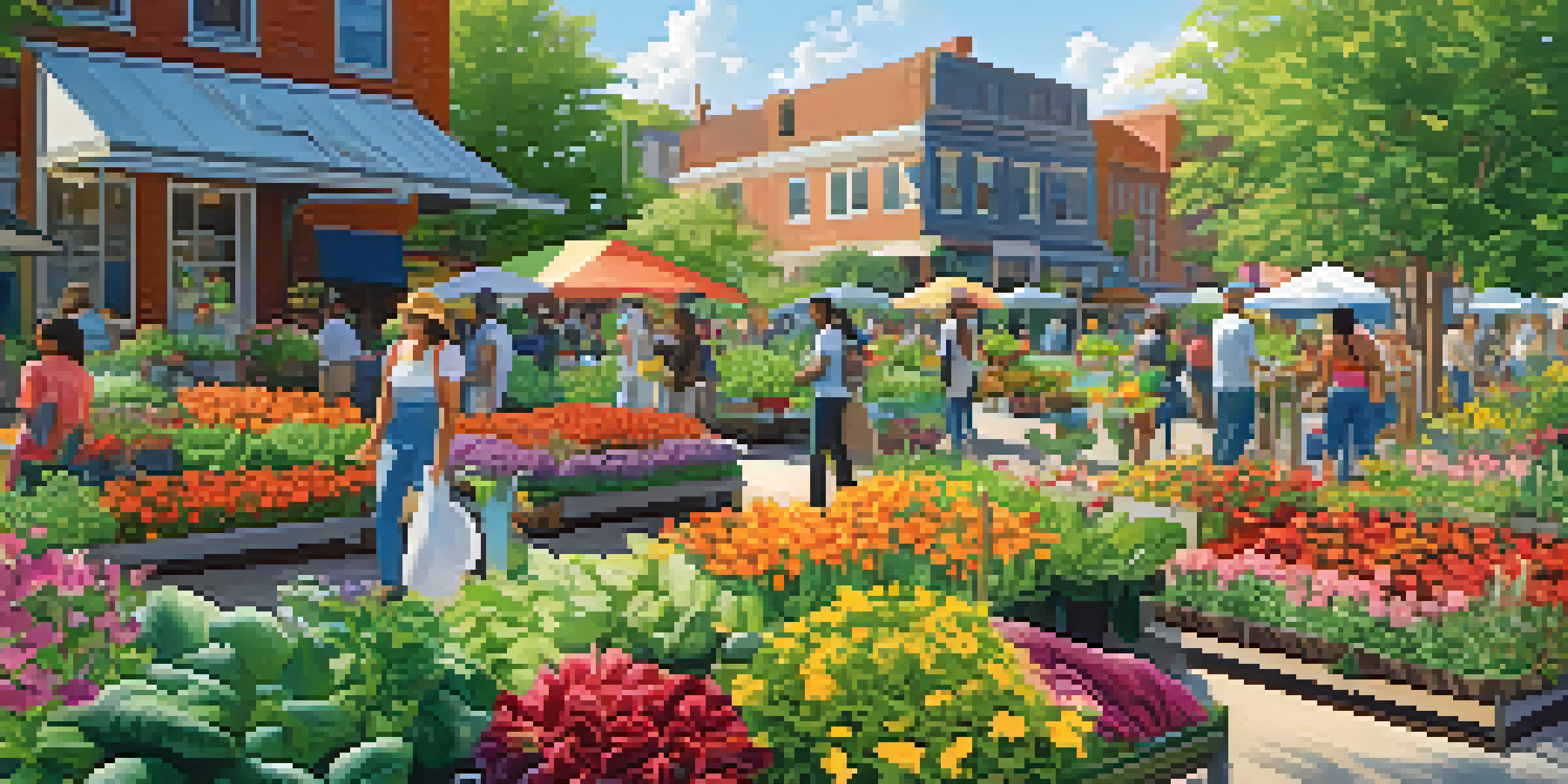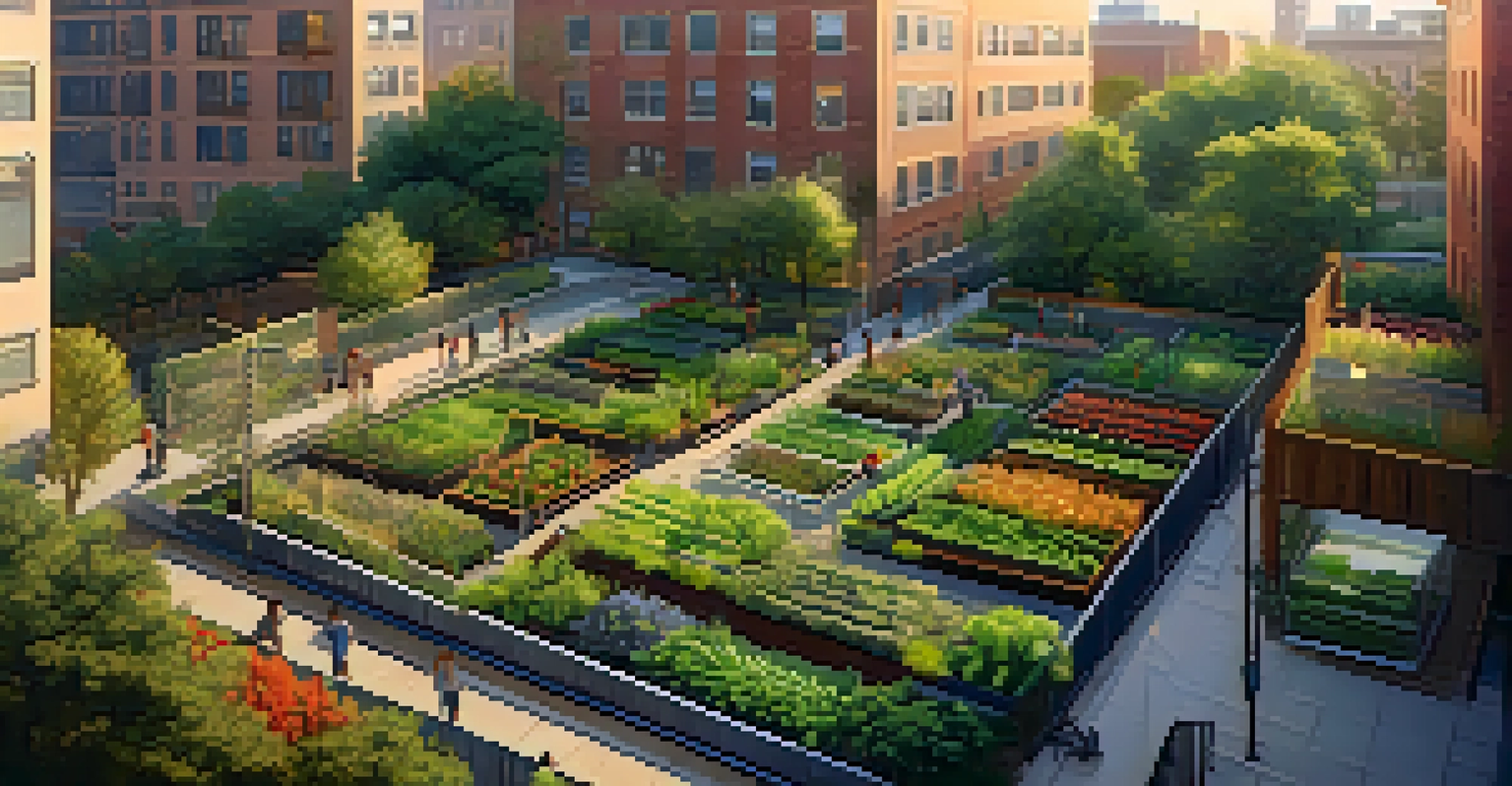Community Gardens in San Francisco: Environmental Benefits

What Are Community Gardens and Their Purpose?
Community gardens are shared spaces where individuals come together to grow plants, vegetables, and flowers. They serve as a vital resource for local communities, providing not just food, but also a sense of belonging and collaboration. In urban environments like San Francisco, these gardens transform vacant lots into green havens, fostering community spirit.
Community gardens are not just about growing food; they are about growing community.
These gardens are often maintained by local residents, which encourages a connection to the land and promotes sustainable practices. By growing their own food, community members reduce their reliance on store-bought produce, which often comes with a hefty carbon footprint. This shift to local food production is essential in combating climate change and promoting environmental stewardship.
Moreover, community gardens often serve educational purposes, teaching participants about gardening techniques, nutrition, and sustainability. Workshops and events held in these spaces foster learning and awareness about environmental issues, creating a ripple effect of knowledge throughout the community.
Enhancing Urban Biodiversity Through Community Gardens
One of the significant environmental benefits of community gardens is their ability to enhance urban biodiversity. In a city landscape dominated by concrete and asphalt, these green spaces provide habitats for various species, including birds, butterflies, and beneficial insects. This biodiversity is crucial for maintaining ecological balance and resilience in urban settings.

By incorporating a variety of plants, community gardens promote the growth of pollinators like bees and hummingbirds, which are vital for the reproduction of many flowering plants. This, in turn, supports the food chain and contributes to a healthier ecosystem. Even small gardens can make a big difference when it comes to supporting local wildlife.
Community Gardens Boost Local Food
These shared spaces enable communities to grow their own food, reducing reliance on store-bought produce and promoting sustainability.
Additionally, the diverse plant life in community gardens helps to improve soil health and reduce pests naturally. Healthy soil not only supports plant growth but also contributes to carbon sequestration, helping to mitigate climate change impacts in urban areas.
Reducing Urban Heat Islands with Green Spaces
Urban heat islands are areas that experience significantly warmer temperatures than their rural surroundings, primarily due to human activities and infrastructure. Community gardens help to counteract this phenomenon by providing green cover that cools the air through a process called evapotranspiration. This natural cooling effect is essential in cities like San Francisco, where heat waves can pose serious health risks.
In every community, there is work to be done. In every nation, there are wounds to heal. In every heart, there is the power to do it.
By increasing greenery in urban areas, community gardens also help to improve air quality. Plants absorb carbon dioxide and release oxygen while filtering pollutants from the air, creating a healthier environment for residents. This is particularly important in densely populated areas where air quality can be compromised by traffic and industrial activities.
Moreover, community gardens can contribute to stormwater management by absorbing rainwater and reducing runoff. This not only helps to prevent flooding but also protects local waterways from pollution, making the urban environment more sustainable.
Promoting Sustainable Practices Through Community Engagement
Community gardens serve as a platform for promoting sustainable practices within local neighborhoods. Participants often share knowledge about organic gardening techniques, composting, and water conservation, fostering an eco-conscious mindset among residents. This hands-on learning experience is invaluable in promoting environmental responsibility.
In addition, these gardens encourage the use of native plants, which are adapted to the local climate and require less water and maintenance. By prioritizing native biodiversity, community gardens help to preserve local ecosystems and reduce the need for chemical fertilizers and pesticides.
Enhancing Urban Biodiversity
Community gardens create vital habitats for wildlife, supporting ecological balance and resilience in urban environments.
The collaborative nature of community gardens also nurtures a sense of responsibility towards the environment. When individuals work together to care for a shared space, they develop a deeper appreciation for the natural world and are more likely to engage in other sustainable practices in their daily lives.
The Role of Community Gardens in Climate Change Mitigation
Community gardens play a crucial role in climate change mitigation by reducing the carbon footprint associated with food production. By growing food locally, communities can significantly cut down on the emissions generated from transporting produce long distances. This localized approach to food sourcing is a powerful tool in combating climate change.
Additionally, these gardens promote carbon sequestration through the cultivation of plants that capture and store carbon dioxide in their biomass and soil. This process not only helps to reduce greenhouse gases in the atmosphere but also improves soil health and fertility over time.
Community gardens also foster resilience against climate impacts by promoting food security. In times of crisis, such as natural disasters or economic downturns, these gardens provide a reliable source of fresh produce, ensuring that communities can sustain themselves even in challenging circumstances.
Creating Community Connections and Strengthening Bonds
Beyond their environmental benefits, community gardens are vital for fostering social connections among residents. These shared spaces create opportunities for individuals from diverse backgrounds to come together, work collaboratively, and share their experiences. This sense of community is essential for building trust and solidarity among neighbors.
Engaging in gardening activities also promotes mental well-being. Spending time in nature has been shown to reduce stress and anxiety, while the act of nurturing plants can be therapeutic. Community gardens provide a peaceful retreat from the hustle and bustle of city life, offering a space for reflection and relaxation.
Fostering Community Connections
These gardens unite residents from diverse backgrounds, promoting social bonds and mental well-being through collaborative gardening activities.
Furthermore, events organized in community gardens—such as potlucks, workshops, and volunteer days—strengthen community ties. They encourage participation and inclusivity, allowing residents to connect on a personal level while working towards a common goal: nurturing the environment and each other.
Challenges Facing Community Gardens in Urban Settings
Despite their numerous benefits, community gardens in urban environments face a range of challenges. One of the most significant hurdles is the constant threat of development and gentrification, which can lead to the loss of green spaces. As cities grow and change, residents may find it increasingly difficult to secure land for gardening projects.
Additionally, community gardens often rely heavily on volunteer participation and funding, which can be inconsistent. Without a dedicated group of volunteers or adequate financial support, these gardens may struggle to thrive. This highlights the need for community advocacy and awareness to ensure their sustainability.

Moreover, issues such as soil contamination and lack of resources can hinder the effectiveness of community gardens. Addressing these challenges requires a collaborative effort from local governments, organizations, and residents to create policies and programs that support urban gardening initiatives.